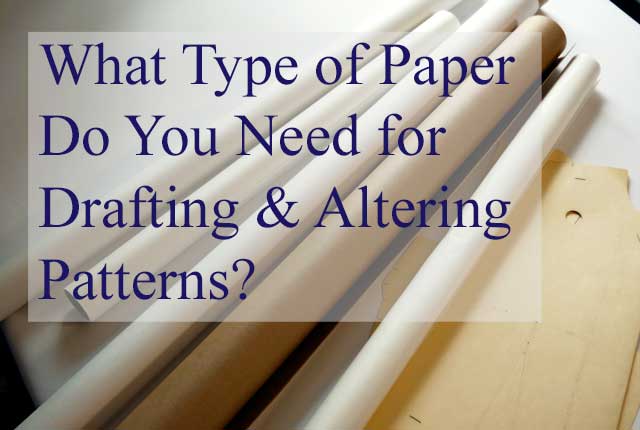
What kind of paper should you use for pattern making and altering patterns?
Well, technically, any kind of paper would work but different types of paper have different qualities and some papers are just better for pattern making, drafting, altering and/or tracing.
In the video, I show you some of the more popular types of paper used for patterns and point out the pros, cons and best uses for each of them.
Read on for the details and links to purchase all of these different pattern making papers.
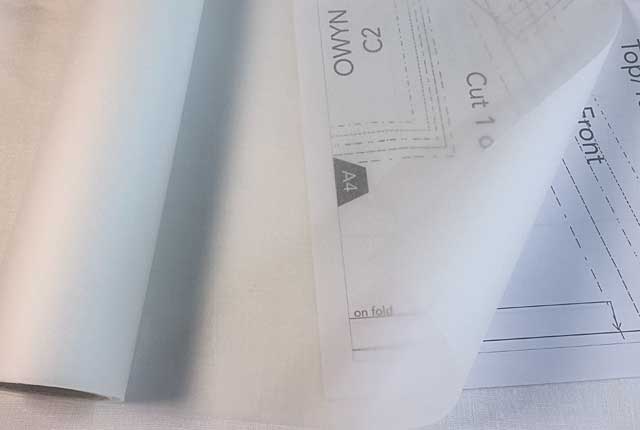
Artist Tracing Paper
This is my usual go-to when tracing off tiled, pdf patterns or any multi-size pattern when I want to keep all the sizes intact. And because it’s so easy to see through, you can easily start tracing one size in the shoulders and move to tracing a different size in the hips, or such.
It’s also useful for tracing a pattern you haven’t sewn up yet but know needs a simple alteration, like a bust adjustment or lengthening. Then after the fitting, you notice no, it didn’t need to be lengthened, or it didn’t need extra length in that particular area, the original is still whole to recopy and do over.
Artist Tracing Paper Pros:
- It comes as wide as 36” so most pattern pieces will fit on it without having to tape pieces of tracing paper together.
- It’s economical a 36” x 50-yard roll is about 50 cents a yard
- Designed to see through easily
And the Cons:
- Its thinness makes it susceptible to tearing especially when erasing
- It can be loud when being moved about (which is not actually a con but if your HSP it can be irritating)
Where to buy Artist Tracing Paper:
All the big names in drafting and art supplies seem to offer rolls of tracing paper. You can purchase a roll at an artist supply store (like Utrecht or Cheap Joe’s) or even a large office supply store (like Staples). Of course, you can order a roll from Blick Art or Amazon.
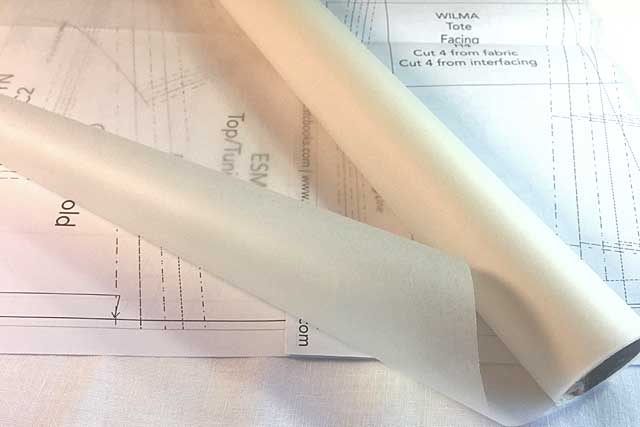
Medical Exam Paper
This paper is very similar to artist tracing paper in weight and transparency. It also comes on a roll but only 21″ wide.
You can use it for everything you use Artist Tracing Parer for.
Medical Exam Paper Pros:
- Very easy to see through
- It’s pretty darn cheap. A 75-yard roll is about 14 cents a yard
And the Cons:
- The width. Many pattern pieces are too large to fit on this paper requiring you to tape pieces of it together for tracing wider pattern pieces
- It’s thinner than tracing paper and tears more easily
Note: Medical Exam paper comes in two finishes; a crepe paper and a smooth finish. The smooth is similar to tracing paper and is what you want for pattern making.
Where to buy Medical Exam Paper:
You can purchase Medical Exam Paper at a medical supply store or order it online.
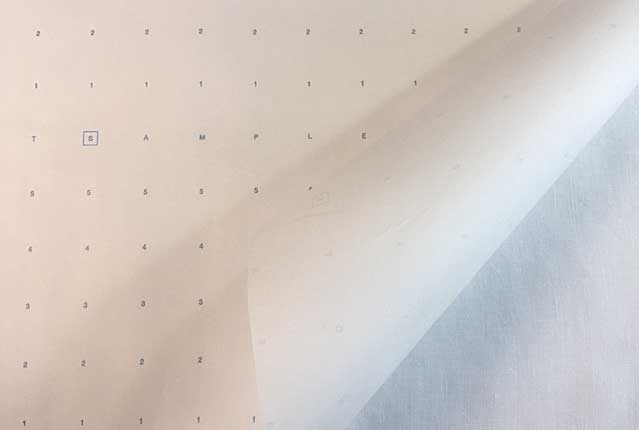
Dot Paper aka Alphabet Paper
This is the paper we used in patternmaking class and actually, all my fashion design classes. Dot Paper is a bright white and has a blue number, letter or other marks placed every inch in both directions forming a grid.
It is not transparent but is see through. To see the pattern you’re tracing even better, place it onto a light colored background and a good light always helps.
This paper is the best for drafting patterns and patterns needing complicated alterations.
Dot paper is easy to cut without tearing. It has more weight than tracing or medical exam paper so it is less likely to curl at every corner, which is appreciated when you need to alter a pattern using slash and spread techniques. Plus marks erase away easily and cleanly and when your altering or drafting a pattern there can be some erasing going on.
Dot Paper Pros:
- It’s wide; 45” which means 99% of your pattern pieces are going to fit.
- Pencil erases away cleanly and without tearing
- Stronger than tracing paper
- You can see through it
And the Cons:
- It’s more expensive per yard (but it is wider) than tracing paper. ($1.20 per yard)
- It’s not easy to find locally.
Where to buy Dot Paper:
Many higher-end fabric stores carry Dot Paper. And again, let your fingers do the walking and order it online from Mood.
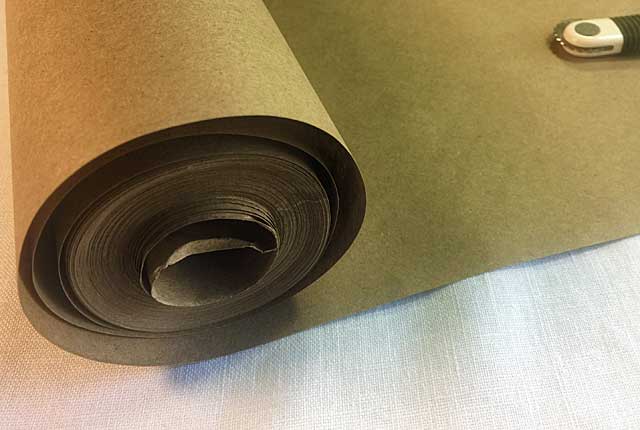
Brown Craft Paper or Butcher Paper
Even though Brown Craft Paper may be the last type of paper you think of when it comes to pattern paper it does have its uses.
No, it’s not good for tracing being completely opaque but there’s more than one way to copy a pattern.
Its stiff nature makes it excellent for tracing garments on to when you’re making a pattern from the garment.
You could also trace off a pattern laying it on top of the Craft Paper and using transfer paper and a tracing wheel. This is a great paper for craft patterns that are repeatedly traced off onto fabric.
Craft Paper is also a good choice for reinforcing patterns you use a lot. Just adhere delicate tissue paper patterns to the craft paper with double stick tape – cheaper than reinforcing tissue patterns with fusible interfacing.
This paper is not easy to manipulate and does not make crisp folds.
Brown Craft Paper Pros:
- It’s 30” wide
- It’s strong and sturdy
- Great for patterns you’ll reuse a lot
- Economical (about 50 cents a yard) and easy to find
And the Cons:
- It’s opaque – so only good for tracing onto with tracing paper and wheel or tracing around an object.
- Folds are not crisp due to thickness.
Where to buy Brown Craft Paper:
You can find Brown Craft Paper at office supply stores, in with packaging and mailing supplies at big box stores and online.
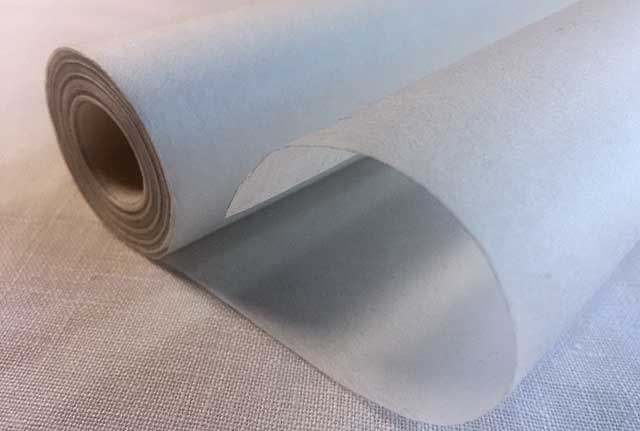
Bonded Textiles (Swedish Tracing Paper)
There are a few brands of bonded textiles on the market although you may know them better by the brand name Swedish Tracing Paper.
Bonded textiles are very similar to non-woven, non-fusible lightweight interfacing (which you could probably use in place of one of these).
All of the types of Bonded Textiles I researched were 100% polyester, claim not to tear, and are sewable. This means you can trace a pattern onto this material, cut it out, baste the pieces together, and check the fit before cutting out your good fabric.
After that, they vary by other features such as being ink jet printable or preprinted with a grid (like Dot Paper), the widths, and the transparency.
Bonded textiles are for tracing off pattern pieces, not for drafting patterns. (Erasability of pencil lines and bleed through of ink could be a problem)
Bonded Textile Pros:
- It won’t tear
- Pattern pieces made with bonded textile will “grip” the fabric they are laid onto. This reduces the number of pins needed and the shifting that occurs when you cut out your fabric.
- You can see through it
- It doesn’t curl like paper.
- It will not disintegrate under a spiky tracing wheel like paper does or with repeated pinning and tailor tacks sewn through them.
- Pieces can be basted together to check for fit
And the Cons:
- Don’t be fooled. Basting the pieces together to check for fit may seem the same as making a muslin but it isn’t. Bonded textiles do not drape like fabric and drape is just as important as fit.
- It’s costly
Where to buy Bonded Textiles:
Some fabric stores carry some of these Bonded Textiles. Pellon’s contenders can be found at larger JoAnn’s. Where I live, I have to order online. (Widths and prices vary by manufacturer and are noted when I could find out)
Pellon 810 tru-grid is 45” wide and has a one-inch grid printed on it which sounds great for enlarging craft patterns. However, some reviews say the grid is not accurate. Pellon 810 cost over $3 a yard.
Pellon 830 Easy Pattern is ink-jet printer safe.
I’m not sure how this with work unless you had a large format printer. Otherwise, you have to cut this into paper size sheets And if you did have a large format printer to print off a pdf pattern there would be a lot of wasted Pellon which at $3 a yard is something to consider.
Bosal is another brand and claims it won’t shrink when you iron it so if you are doing mockups this might be your choice. Bosal is $2.60 a yard
Swedish Tracing Paper is the Kleenex of Bonded Textiles. It’s 29” wide and comes as a 10-yard roll. Swedish Tracing paper cost about a $1.60 per yard.
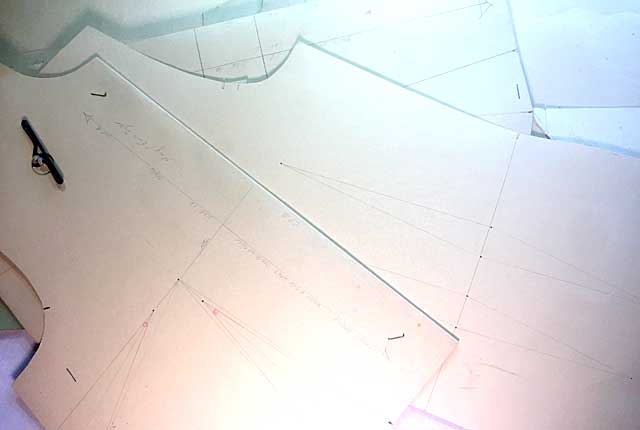
Oak Tag
Oaktag is similar to tagboard in weight and thickness.
It comes 48” wide on a large roll but is also available in 18″ x 24″ sheets too.
It’s used in the industry for slopers. Slopers are the basic blocks used by a pattern maker to draft a new pattern. Because oaktag is thick it can be traced around over and over without distortion to the shape and without tearing at the notch points or other marks made into it.
There really is very little reason a person sewing for themselves would ever need to buy a roll of oak tag. Until you make the move to production sewing substitute easy to find tag board
If you’ve drafted a sloper on paper, or have a pattern you use repeatedly, staple it onto oaktag (or a large piece of tagboard) and cut the oaktag out around the pattern as if cutting out the fabric. In this way, you can accurately and easily transfer your pattern to a more permanent substrate.
Oak Tag Pros:
- It’s very hard to tear
- The thickness allows you to trace off the outline accurately
- Tracing around the pattern multiple times will not distort the pattern’s shape
And the Cons:
- Thickness and opacity means limited uses
- Home sewist will have little use for Oak Tag to justify the cost and space a roll will take up.
Where to buy Oak Tag:
Online unless you live in a city with a garment district. Oak Tag is just under a dollar a yard but with shipping, the cost is more like a $1.50 a yard.
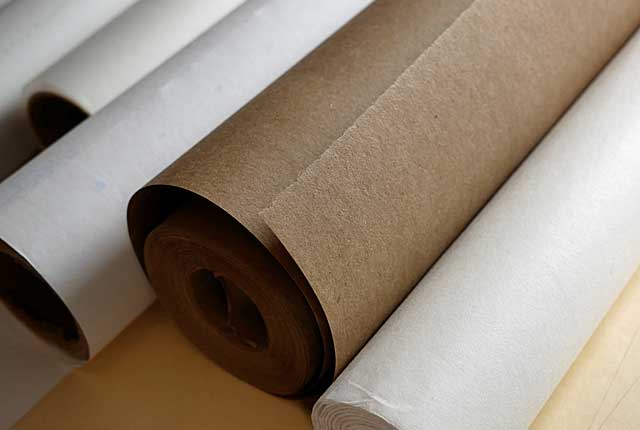
What About Other Types of Paper?
What about using copier paper? Tissue paper? Newspaper?
In a pinch, any paper will do but watch out for ink transferring onto your fabric and hands if you use newspaper.
Watch out for dye transfer if you use tissue paper. Plus tissue paper is so flimsy and can tear when you write on it.
And copier paper is just small in size. If your pattern is small it’s fine. If your pattern is large, get out the tape.
Having the right tools, and this includes paper, does make the job go smoother
A list of links to purchase these papers
Bienfang Tracing Paper – 36” x 50yds

What about baking parchment?
Oh, I hadn’t thought about that but I bet it would work well especially since it’s semi-transparent and very strong.
it can be quite slippy and hard to draw on as seems to be silicone covered these days…
Nice video! I brought some paper from an Art store a few years ago as I was told that would be the best place to get paper used to draft patterns (I wasn’t doing anything then and literally just started).
The paper isn’t thin as the one you have in your vid, it is wide. The challenge I have is that it’s hard to see through and properly trace…and I wear glasses. I was considering the medical paper as I’ve seen many good reviews on it, however, sounds like the width may be an issue….I’m a plus size and very new at doing this so I need all of the width I can get! Thanks so much for doing this video.
I’m glad this had some helpful info for you. Funny, I just ordered a 24″ wide roll of tracing paper yesterday. I was going to order a wider roll, like 36″ but I think I waste more paper with a wide roll. Many of the pattern pieces I trace are not so wide but too wide to get another piece traced next to it. Of course, now that I think harder, 😉 I can fit/trace a lot of pieces (sleeves, some skirt panels) going across the width of the paper. oh well, Let me see how this narrow roll works out and then I’ll update the post.
Hello! Thank you for your reply. Very good to know. I probably wasted some paper this weekend, but I’m ok with it since I’m still new at this 😊
I am looking to do dog clothing patterns that need to be used lots of times. Could you guide me please
You may want to draft your patterns on regular weight paper. After you’ve perfected them staple the pattern onto oaktag or tagboard and cut out around your paper pattern. Go ahead and take your paper pattern off the oaktag pattern. This way if your oaktag pattern gets worn out from use you have the “master” pattern to make another oaktag from OR you have that paper pattern to make a second, third, etc, pattern in oaktag. Oaktag is great for a pattern you will use multiple times. It holds its shape much better than paper.
Years ago I acquired a narrow roll of 1 in lined tissue paper. Roll is about 3+ inches wide. Perfect for adding strips to seams without cutting into large rolls. Having trouble finding more – I’m almost out! Any ideas? Thank you!
That sounds very useful. I’ve never heard of such a paper and don’t know of anything like it. Was it intended to be used for handwriting practice? If so try a school supply type shop, of it was used for art – Blick art supplies. But really, I don’t know. sorry
Try a jewelry supplier. We ordered this often to wrap purchases in.
Good idea. Thank you for letting us know.
This is super helpful! I’ve been using SWT but I want to go plastic-free. Thanks.
yes! I’m trying hard to reduce my plastic too. It’s everywhere when you start to look. And thank you for reading.
I’ve used freezer paper. Trace the pattern on the fp. Bond four to six layers before cutting. Makes sturdy pattern piece.
Great tip. Thanks for sharing. And freezer paper is easy to find and not expensive – Bonus!
Was wondering if I can u a box to trace and cut out the pieces needed that way it lastest longer
Yes, of course. Boxes are a little harder to cut but a pattern made from one will certainly stand up to being traced and retraced. I sometimes use tagboard or cereal boxes.
My mother trained as a Taylor in Ireland long ago. When she was making things for us, (her 5 children) She would cut the pattern pieces out of grocery bags.
Finula
A perfect use for grocery bags! Thanks for the reminder of something we may all have on hand and can reuse. I use brown paper bags for all sorts of crafts – and of course to protect any surface if I’m painting, gluing, being “crafty” – because I’m good at being messy
Hi,
As much as I like Swedish Tracing paper I want to find options that are recyclable or compostable.
I also found a tracing paper that is like a velum in large sheets that was really nice for pattern tracing but not sure if it can be recycled or composted.
I read that some velum that is maybe not coated can be, but not sure.
Vellum is a nice option. I remember using it in art school for projects. Thank you for the suggestion.
I just did some quick reading up on it too. So it is just like other paper, recyclable and compostable. But some vellum is chemically treated to make it transparent. You can tell if it is because it is more brittle and will crack when folded. The good news is most manufacturers will state that their vellum is “foldable” or “eco-friendly” meaning it’s made transparent in the paper-making process, not opaque paper processed chemically to be transparent paper.
Curious if parchment paper may be useful for pattern making for smaller items or children’s clothing? I haven’t experimented yet but just purchased my first digital pattern to make a banana bag and think the size may be a nice option. Would love to hear your thoughts.
I think parchment paper could work just fine. Not sure how transparent it is but you don’t always need it to be either. I think rolls of drafting paper or medical exam paper is cheaper but I also think using what you have on hand, especially if you’re just trying something out, is the best idea. If you find yourself getting into pattern drafting, or altering a lot, then you can buy a large roll of what ever paper you like best. Way to be resourceful.
I use white gift wrapping tissue. It comes in 20×20″ sheets, 40 sheets to the packages, and I just paid $4.49 per package. I also like it best because I can always find it in many different stores.
that’s a great idea. Yes, so much easier to find
I always keep the large white paper that Hobby Lobby uses when they bag your purchases. I just iron these sheet and use them for my smaller pieces. They are great for pattern paper!
This is a Great idea!